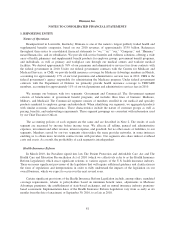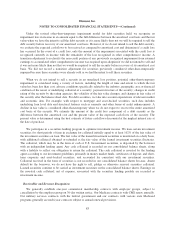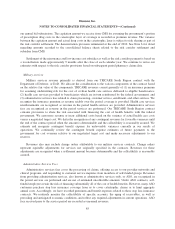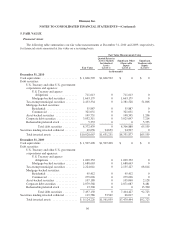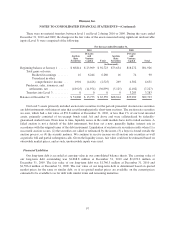Humana 2010 Annual Report Download - page 98
Download and view the complete annual report
Please find page 98 of the 2010 Humana annual report below. You can navigate through the pages in the report by either clicking on the pages listed below, or by using the keyword search tool below to find specific information within the annual report.Humana Inc.
NOTES TO CONSOLIDATED FINANCIAL STATEMENTS—(Continued)
current operations to the extent that the sum of expected future costs, claim adjustment expenses, and
maintenance costs exceeds related future premiums under contract without consideration of investment income.
For purposes of determining premium deficiencies, contracts are grouped in a manner consistent with our method
of acquiring, servicing, and measuring the profitability of such contracts. Losses recognized as a premium
deficiency result in a beneficial effect in subsequent periods as operating losses under these contracts are charged
to the liability previously established. Because the majority of our member contracts renew annually, we do not
anticipate recording a material premium deficiency liability, except when unanticipated adverse events or
changes in circumstances indicate otherwise.
We believe our benefits payable are adequate to cover future claims payments required. However, such
estimates are based on knowledge of current events and anticipated future events. Therefore, the actual liability
could differ materially from the amounts provided.
Future policy benefits payable
Future policy benefits payable include liabilities for long-duration insurance policies including life
insurance, annuities, health, and long-term care policies sold to individuals for which some of the premium
received in the earlier years is intended to pay anticipated benefits to be incurred in future years. These reserves
are recognized on a net level premium method based on interest, mortality, morbidity, withdrawal and
maintenance expense assumptions from published actuarial tables, modified based upon actual experience.
Changes in estimates of these reserves are recognized as an adjustment to benefit expenses in the period the
changes occur.
Book Overdraft
Under our cash management system, checks issued but not yet presented to banks frequently result in
overdraft balances for accounting purposes and are classified as a current liability in the consolidated balance
sheets. Changes in book overdrafts from period to period are reported in the consolidated statement of cash flows
as a financing activity.
Income Taxes
We recognize an asset or liability for the deferred tax consequences of temporary differences between the
tax bases of assets or liabilities and their reported amounts in the consolidated financial statements. These
temporary differences will result in taxable or deductible amounts in future years when the reported amounts of
the assets or liabilities are recovered or settled. We also recognize the future tax benefits such as net operating
and capital loss carryforwards as deferred tax assets. A valuation allowance is provided against these deferred tax
assets if it is more likely than not that some portion or all of the deferred tax assets will not be realized. Future
years’ tax expense may be increased or decreased by adjustments to the valuation allowance or to the estimated
accrual for income taxes.
We record tax benefits when it is more likely than not that the tax return position taken with respect to a
particular transaction will be sustained. A liability, if recorded, is not considered resolved until the statute of
limitations for the relevant taxing authority to examine and challenge the tax position has expired, or the tax
position is ultimately settled through examination, negotiation, or litigation. We classify interest and penalties
associated with uncertain tax positions in our provision for income taxes.
88





